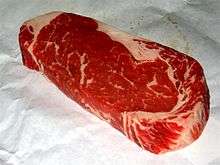Steak Diane
 | |
| Type | Entree |
|---|---|
| Place of origin | United States |
| Main ingredients | beefsteak |
Steak Diane is an American dish of a pan-fried beefsteak with a sauce made from the seasoned pan juices, generally prepared in restaurants tableside, and flambéed. In the 1950s and 1960s, it was considered a classic of "Continental cuisine",[1][2][3][4] and has since become "retro".[5][6]
Origins
"Steak Diane" does not appear in the classics of French cuisine, and was probably invented in mid-20th century New York as part of the fad for tableside-flambéed dishes.[7] The name 'Diane', the Roman goddess of the hunt, has been used for various game-related foods,[8] but the "Venison Steak Diane" attested in 1914, although it is sautéed and flambéed, is sauced and garnished with fruits, unlike later steak Diane recipes,[9] so it is unclear if there is a connection.
By the 1940s, Steak Diane was a common item on the menus of restaurants popular with Café society, including the restaurants at the Drake and Sherry-Netherland hotels and The Colony, one of which may have originated it.[10][11] It is often attributed to Chef Beniamino Schiavon, 'Nino of the Drake'.[4]
Preparation
Steak Diane is similar to steak au poivre.[12] The steak is cut thinly or pounded thin so that it will cook rapidly. It is seasoned with salt and pepper, quickly sautéed in butter, and set aside. A sauce is prepared from the pan juices with various additions, which may include butter, thinly sliced mushrooms, mustard, shallots, cream, truffles, meat stock, A1 Steak Sauce, and Worcestershire sauce. The sauce is flambéed with brandy, dry sherry, or Madeira, and poured over the steak.
See also
- List of steak dishes

References
- ↑ Max Jacobson, "Blast from a tasty past", Los Angeles Times, March 26, 1998 : "steak Diane and all the other Continental dishes an up-to-date foodie would be embarrassed to admit knowing of"
- ↑ Lobel's Culinary Club, August 17, 2012 : "Steak Diane is among those popular dishes in ubiquitous cosmopolitan, Continental-style restaurants of the 1950s and ’60s that combined high style with leather banquettes, white-linen table cloths and dishes of American and European influences, a bit of theater and dramatic preparation."
- ↑ Mark R. Vogel, "Diana: The Legacy of the Huntress", FoodReference : "One thing is for sure. Steak Diane was the rage in the 50’s and early 60’s, especially in New York."
- 1 2 Pierre Franey, "60-Minute Gourmet; Steak Diane", New York Times, January 31, 1979
- ↑ Florence Fabricant, "New Wave in the East River: David Burke", New York Times November 9, 1988, characterizes it as "retro"
- ↑ Leah Koenig, "Lost Foods of New York City: Steak Diane", Politico, March 14, 2012 : "Lost Foods of New York City is a column that celebrates the food and drink that once fed the city, but have disappeared.... America’s collective obsession with all things mid-century New York City is back in full martini-slinging force. What better time, then, to celebrate steak Diane—a dish so quintessentially retro-glamorous, it might as well be called steak Don Draper."
- ↑ John Fuller, Guéridon and Lamp Cookery: A Complete Guide to Side-table and Flambé Service, 1964, p. 69
- ↑ Larousse Gastronomique, 1st edition "Oeufs à la Diane", with purée of game; Bécasse (woodcock) à la Diane; etc.; Larousse Gastronomique, 2001 edition, p. 416; Sauce Diane, a sauce poivrade with cream, truffle, and hard-boiled egg white served with venison in Escoffier's Guide Culinaire (1907)
- ↑ A.C. Hoff, ed., Steaks, Chops and Fancy Egg Dishes, International Cooking Library, International Publishing Co., 1914, p. 20 full text
- ↑ Arthur Schwarts, "'21's Steak Diane", quoting from Arthur Schwartz, New York City Food: An Opinionated History and More Than 100 Legendary Recipes, 2008
- ↑ Jane Nickerson, "Steak Worthy of the Name", New York Times January 25, 1953, p. SM32, as quoted in Olver, Lynne (2000). "Steak Diane". History Notes. The Food Timeline.
- ↑ Mark Bittman, "The Minimalist: A Tender Celebration", New York Times, 8 February 2006 full text
